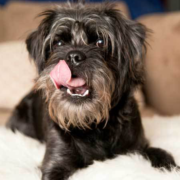Anatolian Shepherd
Description
The Anatolian Shepherd are known for their large, strong frame and their courage. Steady and bold, but never aggressive. The Anatolian Shepherd are loyal and independent. At some point Anatolian Shepherds were once used to hunt wolves, but today in the United States they are used for hunting, military purposes and as sheepdogs. Similar in looks to the Great Pyrenees, the Anatolian Shepherd has a tighter frame and is more agile.
Size of Male: Height: 28-29 inches Weight: 110-150 pounds
Size of Female: Height: 27-28 inches Weight: 80-120 pounds
Temperament
The Anatolian Shepherd is a very loyal, alert and possessive dog. The Anatolian Shepherd is intelligent and easy to train, but is not a dog for beginners. The Anatolian Shepherd needs a handler who naturally radiates leadership. The Anatolian Shepherd is calm, steadfast and brave, but not aggressive. It is also independent, very watchful, proud and self-assured. Affectionate with their own family, but suspicious of strangers, especially after reaching adulthood. Strangers should be formally introduced before the mature dog is asked to accept them. The Anatolian Shepherd is possessive with respect to its home and property and will not allow anyone into the family property if the owner is not home, unless it has had frequent contact with the person, but he is fairly friendly with those people the family accepts. The dog is demanding of itself, and can be stubborn and dominant. When training the Anatolian Shepherd, the best results are achieved by motivational training methods with a determined, consistent and loving approach. It is very important to begin training as early as possible, because an adult dog may be too strong and big to be corrected. The Anatolian Shepherd has his own ideas and will not cater to his owner’s every whim. Sensitive to reprimands and eager to receive affection, this breed is patient and protective with children of the family, but may accidentally knock them down. Children should always be supervised and properly introduced. The Anatolian Shepherd does not require any additional protection training. It already has very strong protection instincts that grow as the dog matures, often coming suddenly to the fore at around one and a half years of age. They will generally get along with other animals provided they have been introduced to them when they are still young. They can be rather dominant towards other dogs and it is important to socialize them while they are still young. These dogs mature quite slowly, reaching full adulthood at about four years old.
Living Conditions
The Anatolian Shepherd is not recommended for apartment life. This is mostly because the Anatolian Shepherd is relatively inactive indoors and will do best with at least a large yard. The Anatolian Shepherd is very suspicious of strangers, and it is therefore necessary to provide a secure, fenced yard. However, like many other dogs, the Anatolian shepherd can be an apartment dog if owner is committed to bring the dog for exercise daily and consistently.
Upkeep
The Anatolian Shepherd needs a chance to exercise every day, either with a long walk or brisk run. Anatolian Shepherd can live outside in temperate to cool climates. Coat care for Anatolian Shepherd is minimal, consisting only of a weekly brushing to remove dead hair. Since it also can stay outdoors in a yard, families looking for a low maintenance dog, if a large yard is available and good training is done in the socialization period, can consider the Anatolian Shepherd.
Health
Major concerns: Hip dysplasia
Minor concerns: Eyelid entropion, Skin problems
Life expectancy: 10 – 13 years


